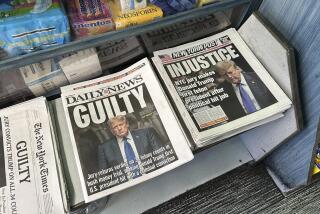Iraq Stockpiles and TV News Is a Dog Show
- Share via
The new Barry Levinson film “Wag the Dog” takes a satirical swipe at politicians’ manipulation of the press. Robert DeNiro plays a spin doctor hired to rescue the president’s reelection bid after he becomes ensnared in a sex scandal. DeNiro teams up with a Hollywood producer (Dustin Hoffman) to create a media diversion--a war with Albania. A few days of lavish news coverage of the mounting international tensions and suddenly the sexual allegations seem trivial.
The idea that the media could be fooled about a war for more than a few hours is farcical. But in today’s Washington, it’s all too true that the savvy deployment of image politics can distract and deter reporters from effective coverage of public affairs. More than 30 years ago, historian Daniel Boorstin first warned that the press was replacing real reporting with “a flood of pseudo-events”--precooked images and soundbites that are easy to report and even easier to digest. Bill Clinton, the man from Hot Springs, er, I mean Hope, has proved master of the mass-mediated presidency.
Hounded by allegations of waggish behavior toward lounge singer Gennifer Flowers, Clinton and his wife took to the air waves and turned a seamy scandal into an upbeat campaign theme. “The problems are about what’s going to happen to families in New Hampshire and the rest of the country in the future, and not what happened to mine in the past,” he said on “60 Minutes.”
Five years later and the wagging hasn’t let up. A national dialogue was held to name the new White House dog. As one well-staged photo op turned into weeks of feverish puppy updates, network bureau chiefs were falling all over themselves to break the Buddy name exclusive.
On the day of the president’s last press conference of 1997, Iraqi leader Saddam Hussein was thumbing his nose at arms inspectors, and Vice President Al Gore faced new disclosures of fund-raising indiscretions. But it was the heartwarming story of the president’s new pooch that held the public in thrall. Can a president who nuzzles a puppy and names it after a cherished uncle really be a bad guy? And the bark goes on: Buddy goes to Renaissance, Buddy hops into the presidential limousine, Buddy relieves himself in the Rose Garden. And let’s not forget the president presiding over the Socks-Buddy “summit” on the White House lawn.
Just weeks before his deposition in the Paula Jones case, the president and his wife had their “privacy invaded” (complained Press Secretary Mike McCurry). On the Caribbean island of St. Thomas, cameras caught the first couple locked in a romantic beach waltz. The White House’s faint protest about the photos set off a national debate about press tactics, which in turn sent the networks scrambling to air the footage of the dance.
Then, on the day after the deposition and as reports surfaced of an alleged presidential dalliance with a former White House staffer--Clinton and the first lady were snapped leaving church. The huge Page 1 photo in Monday’s Washington Post showed the president beaming, a Bible clutched in one hand and the other hand slipped through his wife’s.
Of course press manipulation is as old as politics. President Kennedy never missed a chance to be filmed with his family or boating, reinforcing the image of a vigorous family man when in reality he was an unfaithful husband with a bad back. And it was no coincidence that Ronald Reagan chopped wood and rode horses in camera range as concerns about his age and stamina persisted.
Occasional human interest stories about politicians can provide insight into how their views were shaped. But saturating the airwaves with poignant presidential moments not only glosses over ethical questions but also shifts time and focus away from issues of real import. As Boorstin wrote, because “pseudo-events” are more “attractive” than real news events, they “tend to drive all other kinds of events out of our consciousness.”
With every story on the sand dance, we learned less about the implications of the Asian currency crisis. With every feature on Chelsea’s college decision, we learned less about the president’s decision to keep troops in Bosnia. Most people are too busy to do research on the Internet, read three newspapers or glue themselves to C-Span all day. So television news is their primary source of information about the world. Television executives claim that ratings and financial pressures drive them to offer lighter fare but fail to acknowledge that the public demand for “pseudo-events” follows decades of increasing media reliance on contrived moments to spice up broadcasts.
Hard news programs will never get “Seinfeld” ratings. But then again, they are not supposed to be shows about nothing.
More to Read
Sign up for Essential California
The most important California stories and recommendations in your inbox every morning.
You may occasionally receive promotional content from the Los Angeles Times.













